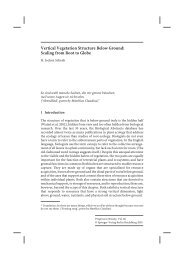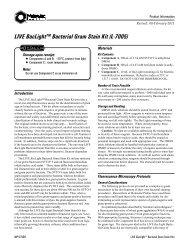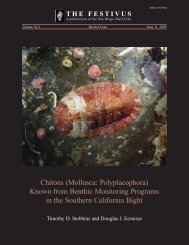Landscape Evolution at an Active Plate Margin - Biological Science ...
Landscape Evolution at an Active Plate Margin - Biological Science ...
Landscape Evolution at an Active Plate Margin - Biological Science ...
Create successful ePaper yourself
Turn your PDF publications into a flip-book with our unique Google optimized e-Paper software.
vironmental opposition has delayed pl<strong>an</strong>s. During a<br />
visit in 2008 no evidence of recent activity was noted.<br />
Mine Development Associ<strong>at</strong>es (2008) reports th<strong>at</strong> the<br />
gold deposit is underlain by rock units rel<strong>at</strong>ed to caldera<br />
form<strong>at</strong>ion <strong>an</strong>d subsequent resurgence. Lithologies<br />
include volc<strong>an</strong>iclastic siltstones <strong>an</strong>d s<strong>an</strong>dstones<br />
deposited in a lacustrine setting within the caldera,<br />
debris flows with local intercal<strong>at</strong>ed silica sinter, <strong>an</strong>d<br />
rhyolite flows <strong>an</strong>d dikes. All lithologies have been<br />
altered <strong>an</strong>d/or mineralized to various degrees.<br />
The north–south trending Hilton Creek fault defines<br />
the eastern limit of the resurgent dome within the<br />
central part of the Long Valley caldera <strong>an</strong>d extends<br />
beyond the caldera to the south. Vista believes th<strong>at</strong><br />
this fault system controls the distribution of gold<br />
mineraliz<strong>at</strong>ion <strong>at</strong> the Blue Chert deposit.<br />
The epithermal (hot springs) gold <strong>an</strong>d silver mineraliz<strong>at</strong>ion<br />
falls within the low sulfid<strong>at</strong>ion (quartz–<br />
adularia) deposit type. Several favorable explor<strong>at</strong>ion<br />
targets, termed the North, Central, South, Southeast,<br />
<strong>an</strong>d Hilton Creek zones, are mineralized with low<br />
grades of gold <strong>an</strong>d silver along north–south trending<br />
zones up to 8,000 ft in length with widths r<strong>an</strong>ging<br />
from 500 ft to 1500 ft. The tabular bodies are generally<br />
fl<strong>at</strong>-lying or have shallow easterly dips. Mineralized<br />
zones are typically from 50 to 200 ft thick <strong>an</strong>d<br />
exposed <strong>at</strong> (or very near) the surface. These zones<br />
correl<strong>at</strong>e with areas of intense argillic alter<strong>at</strong>ion <strong>an</strong>d/<br />
or silicific<strong>at</strong>ion. The predomin<strong>an</strong>t clay mineral is kaolinite,<br />
while the silicific<strong>at</strong>ion varies from chalcedony<br />
to amethystine quartz or opal. Multiple periods of<br />
brecci<strong>at</strong>ion <strong>an</strong>d silicific<strong>at</strong>ion are evidenced by crosscutting<br />
veinlets <strong>an</strong>d silicified breccia zones.<br />
Mineraliz<strong>at</strong>ion consists of poorly crystalline pyrite,<br />
often with framboidal texture, <strong>an</strong>d lesser euhedral<br />
pyrite. Investig<strong>at</strong>ions have shown submicroscopic<br />
gold occurs within the framboidal pyrite. Where gold<br />
grains have been observed, the grains are small (1 to<br />
6 microns) <strong>an</strong>d have low amounts of contained silver.<br />
A signific<strong>an</strong>t portion of the gold resource is present in<br />
m<strong>at</strong>erial which has been <strong>at</strong> least partly oxidized. The<br />
pyrite is altered to iron oxides (goethite), releasing the<br />
gold. See Jessey (this volume), for discussion of ore<br />
genesis <strong>an</strong>d a model for ore deposition.<br />
This fossil hot spring hill is in the lower reaches of a<br />
Jeffrey pine (Pinus jeffreyi) forest covering much of<br />
the Long Valley resurgent dome. Individual pines c<strong>an</strong><br />
be seen in sagebrush scrub of Long Valley south <strong>an</strong>d<br />
D. R. Jessey <strong>an</strong>d R. E. Reynolds<br />
east to Benton Crossing Road. Jeffrey pine extends<br />
from Baja California to the Siskiyou Mountains in<br />
northern California, where it is found on ultramaficderived<br />
soils. Typically the Jeffrey pine is found on<br />
well drained soils <strong>at</strong> elev<strong>at</strong>ions from 6000 ft. to 8000<br />
feet. At higher elev<strong>at</strong>ions (Mammoth Lakes), Jeffrey<br />
pine is replaced by California red fir (Abies magnifica)<br />
<strong>an</strong>d then Sierra lodgepole pine (Pinus contorta ssp.<br />
murray<strong>an</strong>a). Highest elev<strong>at</strong>ion trees are the whitebark<br />
pine (Pinus albicaulis), which form krummholtz in<br />
windswept areas. Logging tr<strong>an</strong>sported timber by rail<br />
to Bodie, where it became mine timbers, stamp mills,<br />
<strong>an</strong>d siding for bars <strong>an</strong>d brothels.<br />
Gre<strong>at</strong> Basin sagebrush to the east gives way to seasonally<br />
wet alkaline meadows in Long Valley. These<br />
wet “saltgrass meadows” are fed by streams slowly<br />
me<strong>an</strong>dering to the Owens River. Saltgrass (Distichlis<br />
spic<strong>at</strong>a) is domin<strong>an</strong>t, while other import<strong>an</strong>t halophytic<br />
pl<strong>an</strong>ts include clustered field sedge (Carex praegracilis),<br />
arrow grass (Triglochin maritima), <strong>an</strong>d clustered<br />
goldenweed (Pyrrocoma racemosa). The closest<br />
published flora to Long Valley is northeast <strong>at</strong> Glass<br />
Mountain (el. 11,123 ft) towering 4,400 feet above the<br />
Owens River in the floor of Long Valley (Honer, 2001;<br />
Michael Honer of R<strong>an</strong>cho S<strong>an</strong>ta Ana Bot<strong>an</strong>ic Garden)<br />
This study samples saltgrass meadows, sagebrush<br />
series, subalpine forests <strong>an</strong>d meadows, <strong>an</strong>d arid alpine<br />
peaks <strong>an</strong>d ridges.<br />
RETRACE via Antelope Springs Road (3S05) to<br />
Highway 395.<br />
87.0 .(1.4) TURN RIGHT <strong>at</strong> Huntley Mine <strong>an</strong>d 5-way<br />
intersection.<br />
87.9 (0.9) Pass a left turn; continue on graded road.<br />
90.4 (2.5) TURN RIGHT on Owens River Road.<br />
90.9 (0.5) Cross Hot Creek.<br />
91.0 (0.1) TURN RIGHT on Hot Creek H<strong>at</strong>chery<br />
Road toward Whitmore Tubs Road.<br />
91.6 (0.6) BEAR LEFT on 2507 toward Whitmore<br />
Hot Springs. Avoid Hot Creek Road to the right.<br />
92.9 (1.3) STOP 2-10. Regroup <strong>at</strong> View Stop. From<br />
the rise, view 12:00 to 1:00 of moraines <strong>at</strong> Convict<br />
Creek; 11:00 moraines in McGee Creek; 10:00 moraines<br />
in Rock Creek.<br />
93.1 (0.2) Continue past a left turn.<br />
94.4 (1.3) Stop sign <strong>at</strong> junction of paved Benton<br />
Crossing Road (2584). Whitmore Hot Springs are<br />
42 2009 Desert Symposium
















